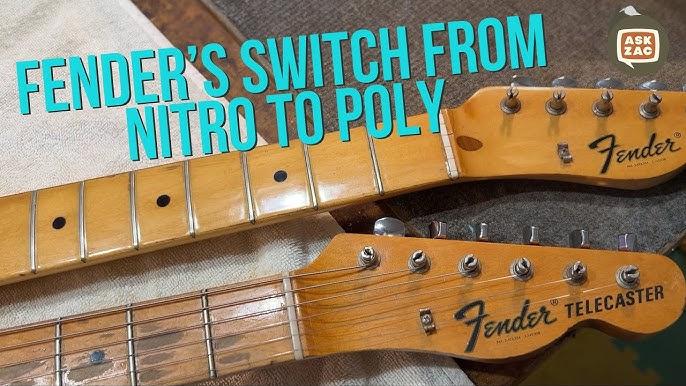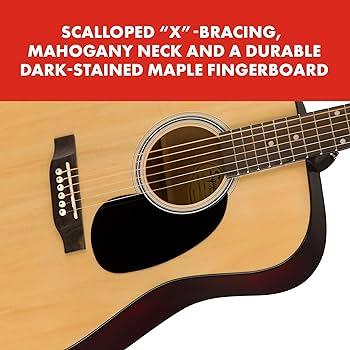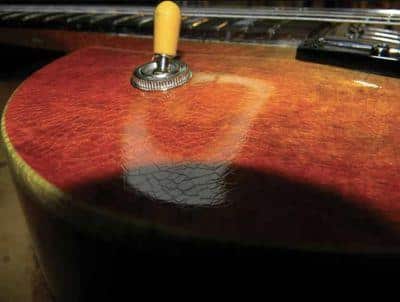What if I told you that your guitar’s finish might be holding you back? That, despite the sleek aesthetic appeal, it may be inhibiting the true voice of your instrument? As a luthier with a background in engineering, I’ve delved deep into understanding the intricate relationship between a guitar’s finish and its sound. It all began when I encountered a guitar with a nitrocellulose finish.
Welcome to the world of nitrocellulose, a substance that, I’ve learned, has a profound impact on guitars’ tone and playability. However, nitrocellulose is just one contender in the arena of guitar finishes. Polyurethane, polyester, and other finishes each present certain appeals and drawbacks as well. And the question remains: how do we measure their impact on a guitar’s sound and performance?
Within this fascinating domain, I discovered that a single decision – the choice of guitar finish – can affect the instrument’s sonic delivery. But when it came to the nitrocellulose guitar finish, the results were unexpected. Far from being a simple formality or aesthetic choice, it turned out to be a crucial element that could elevate or hinder an instrument’s potential.
So, it’s time we undertake a comprehensive guitar finish comparison. In doing so, we will shed light on the impact of finishes not only on a guitar’s tone but its overall playability as well. This knowledge will empower every guitarist out there to make more informed decisions about their beloved instrument, and consequently, to reach new heights in their musical explorations.
So, are you ready to dive deep into this oft-overlooked aspect of guitar anatomy? If so, buckle up, and let’s explore together the world of guitar finishes, starting with the intriguing nitrocellulose, and how it shapes your guitar’s voice and feel.
Understanding Guitar Finishes
Nitrocellulose Finish

As we delve deeper into the realm of guitar finishes, the fascinating world of nitrocellulose finish comes into focus. My fascination with this finish has sharpened over the years, fueled by countless hours spent studying, applying, and really listening to the subtle tonal changes it imparts. Undoubtedly a gem in my portfolio of guitar finishes, it commands a detailed exploration.
A nitrocellulose guitar finish is an evaporative finish solvent that dries by releasing solvents into the atmosphere. The intricate process leaves behind thin, crisp layers that resonate beautifully. Over time, this finish slightly contracts, allowing the wood of the guitar to ‘breathe’ and mature its tone – an acoustic marvel that other finishes seldom replicate.
Contrary to popular belief, there is something deeply scientific, almost poetic, about this finish. The elasticity and thinness of a nitrocellulose finish affect how the wood vibrates, subtly impacting the tone and playability of the guitar. Though seemingly infinitesimal in detail, these distinctions cumulatively can contribute to a decidedly different sound that a discerning ear can appreciate.
Understanding the nitrocellulose finish is to grasp the very heart of guitar construction. It is the complex interplay between what we see – the tangible, aesthetic appeal – and what we hear, the tonal depth that gives a guitar its character. From my experience, there’s something incredibly rewarding about the patience this finish demands and the tonal richness it reciprocates with.
As we turn towards the comparison with other finishes in the next section, keep in mind the unique qualities of nitrocellulose – its interaction with sound, its effects on playability, and its contribution to the guitar’s evolving story.
Polyurethane and Other Finishes

As an experienced luthier, I’ve worked with diverse guitar finishes, including the incredibly popular polyurethane finish. Unlike nitrocellulose finishes—quietly known for their porous nature and capacity to allow the guitar’s wood to breathe—polyurethane does the exact opposite. It’s less porous, providing a slick, crystal-clear sheen that encapsulates the guitar’s exterior. This comprehensive coverage assures the guitar is well-protected from minor scratches and bumps.
Polyurethane guitar finishes are applauded for their longevity and resistance to wear and tear. However, with this advantage comes a controversial drawback for some guitar aficionados. The all-encompassing, highly protective nature of the polyurethane finish can deter the natural vibrations of the guitar’s wood, theoretically imposing on the instrument’s ultimate tone and playability.
In line with this, one cannot discuss polyurethane without mentioning its closely related kin, the polyester guitar finish. Much like polyurethane, polyester creates a fortified outer layer that offers a high level of protection. Polyester finishes are most known for their glossy, high-shine finish, often used to give electric guitars that rock-star aesthetic.
My experiences working with polyurethane and polyester finishes have taught me that no finish is superior—it all boomerangs back to individual preference. You may value the protection of non-porous guitar finishes, or you may be attracted to the aged quality that comes with the more delicate, porous guitar finishes. As you cultivate your knowledge of guitar finishes, it’s important to weigh these considerations, always remembering that the perfect finish for you is one that aligns with your personal needs as a guitarist.
Application Process

Delving deeper into the realm of guitar finishes, we can ascertain that the finish application process indeed plays an indispensable role in refining aesthetic appeal and defining the unique character of a guitar’s tone. My tenure in this field has allowed me to master this fine art, revealing that meticulous attention to process nuances can essentially set the stage for the look and sound of the instrument.
Before jumping into comparing nitrocellulose with other finish types, I believe it’s crucial to highlight the importance of the finish application process. I’ve learned, during my journey, that it’s not just the type of finish, but how it’s applied that truly impacts playability and tone.
As a luthier, I can’t emphasize enough the intricate care that’s required in this process. From the initial prep work of sanding to the pivotal role of a finisher who accurately sprays layers of finish onto the guitar, every detail is a contributor. The journey from the choice of finish to its implementation, this process holds the power to change the overall game. Too much finish can mute the wooden vibrations and alter the tone, while too little finish can leave the guitar vulnerable to damage and wear.
Indeed, the finish application process serves as a make or break point not just for the guitar’s aesthetics but significantly for its sound and playability. It isn’t merely about spreading layers of finish; it’s about playing with materials, colors, and the artistic intuition of the luthier pouring their soul into the creation, thereby breathing life into the guitar.
As we venture further into comparing nitrocellulose and other finish types, remember that their impact on a guitar’s tone isn’t just inherent to their chemical properties, but also to the masterful application process.
Comparing Nitro and Other Finishes
Impact on Guitar Tone and Playability

After discussing the composition and application processes of different guitar finishes, an understanding of their impact on guitar tone and playability is essential. My expertise and experience have made me acutely aware of how finishes influence a guitar’s sound, particularly the distinct resonance of thin nitro finish guitars.
The makeup of a finish can significantly alter a guitar’s tone. Nitrocellulose finishes, being thinner, allow the guitar wood to resonate more freely. This results in a richer, warmer sound. As someone who’s played and constructed countless guitars, I can testify to the naturally-aged tone that these finishes bring to the table. Their ability to facilitate a livelier, nuanced sound spectrum is nothing short of impressive.
Thicker finishes, like polyurethane, however, tend to dampen guitar resonance to a certain degree due to their heavier composition. Their tight seal over the wood inhibits its natural vibrations. As such, while they might offer more protection, they can compromise the guitar’s tone.
When assessing the playability of a guitar, the smoothness and grip of the finish are factors to consider. In my experience, nitro finishes have provided a more comfortable grip, enhancing the overall playing experience. But remember, the effects of finishes on sound and playability can vary depending on individual preferences and playing style.
In conclusion, there is no universal ‘best’ option. The decision between a thin nitro finish and other finishes should primarily be guided by what you value more—tonal quality or durability. As we’ll discuss later, factors like maintenance and cost are also key considerations. This exploration into finishes and their impact aims not to favor one over the other, but to prepare you to make an informed choice based on your personal needs and ideals.
Durability and Cost

As we delve deeper into the comparison between nitrocellulose and other finishes, we must consider the elements of durability and costs tied to these. My hands-on experience with a variety of guitars allows me to evaluate these factors firsthand. One cannot deny the impact of a guitar finish on its longevity and total cost, making these substantially relevant aspects in our comparative journey.
Let’s consider nitro finishes first. They have a peculiar, soft appeal, which can bear the brunt of every note you strum. However, over time, they tend to wear faster, showing signs of checking, peeling, or gouging – making them less sturdy in the finish durability guitars category. This wear, for some players, becomes a part of the guitar’s history, adding to its character.
Yet, while the nitro finish cost may initially seem quite attractive, we should remember that their maintenance can quickly add up. Let’s not forget the nature of nitro finishes – they require more touch-ups and refinishing sessions. Consequently, the overall nitro finish cost can turn out higher than anticipated.
Comparatively, finishes like polyurethane and polyesters, commonly found in contemporary guitars, may lack nitro’s classic appeal but offer notable advantages. They are highly resistant to scratches, checkings, and even climate impacts, making them a robust player in finish durability guitars discussions. As a result, these finishes are more cost-effective in the long run, as they’re less likely to need frequent touch-ups or refinishing.
However, it’s important to balance durability and cost with other factors, such as overall guitar tone and playability, which we will be exploring next. As we traverse through the various facets that define a guitar, remember that a thoughtful blend of all these elements forms the perfect instrument for you. The finish is just one piece in this vast puzzle of strings, frets, tones, and resonance.
Advice from Luthiers

Steering into the heart of our discussion on finish comparisons, let’s distill some invaluable luthier advice on finishes. As an active participant within the New England Luthiers’ circle, we’ve frequently discussed the nuances of various guitar finishes, giving me a well-rounded view of the topic.
Nitrocellulose, revered for its tonal superiority, allows the wood of the guitar to resonate more freely. However, it is worth noting that the impact of a finish on tone is often most pronounced among high-end guitars. If the inherent tonal quality of a guitar isn’t exceptional to start with, the choice of finish – nitro or otherwise – may not make audible difference.
I learned through seasoned luthiers that nitro finishes are not without their drawbacks. They are highly susceptible to wear, are sensitive to heat and moisture, and over time they will crack and check. A significant amount of care and maintenance is necessary to keep a nitro finish in pristine condition, making it a less forgiving option for the casual player.
By contrast, polyurethane and other finishes produce a more durable, low-maintenance option. Even though they may not have the reputed tonal advantage of nitro, modern technology advancements have significantly narrowed this gap. For many players, the practicalities of a reliable and hard-wearing finish outweigh the potential tonal benefits of nitrocellulose.
Irrespective of the finish, professional luthiers advise on the importance of quality application. A poorly applied finish, regardless of its type, can adversely influence the overall tone and playability of a guitar.
In conclusion, the best finish for a guitar is largely dependent on your individual needs and priorities as a guitarist. If tone is of utmost importance, nitrocellulose might indeed prove to be the best option. However, if durability and ease of maintenance are significant considerations, a polyurethane or another finish may be more suitable. Above all, luthier advice on finishes stresses the need for a harmonious balance between aesthetic appeal, tonal quality, and practical functionality, as defined by the individual guitarist’s expectations.
Let’s now delve into how these finishes impact the instrument’s tone and playability, embedding our newfound luthier insights into the grander scheme of the discussion.
Maintaining a Nitro Finish

Over time, I’ve discovered that maintaining a nitro finish isn’t just a matter of preserving the guitar’s physical appearance. It’s about preserving the rich, dynamic tones only characteristic of a nitro finish. Our guitars are our companions in music—we should treat them with the same care we’d give to a dear friend. From knowledge on guitar strap interaction to the peculiar reactivity of nitro finishes, here’s a meticulous guide to nitro finish care from my long-held journey with the six-string.
Understanding the reactivity of nitro finishes is the first crucial step. Unlike polyurethane and other finishes, nitrocellulose is susceptible to plasticizers—substances added to materials to increase their flexibility. Take PVC for example, a common material used in guitar straps and stands. When a PVC guitar stand or strap comes in contact with a nitro finish, it can wreak havoc, causing a chemical reaction that ultimately damages the finish.
Taking care of a nitro finish is like nursing a bottle of fine wine. Ready to find out why?
Nitro finishes cure over time, just like fine wines age and develop character. These finishes are prized for their ageing process that enhances the instrument’s tone quality and aesthetic over time. However, unlike other finishes, they also require more specific care due to their delicate nature. Guitar maintenance, especially for nitro finishes, isn’t merely about polishing; it’s about safeguarding that ageing process.
With the unique proclivity for guitar strap interaction, you’d want to ensure you’re using a strap with materials that don’t react negatively with nitro finishes. Leather and cotton are safe bets. Be mindful when choosing guitar stands as well, staying clear from those with rubber, foam, or plastic elements that make contact with your guitar’s finish.
Another characteristic of nitro finish care is that unlike other finishes, nitro doesn’t seal off the wood completely. Cleaning therefore requires gentleness and care. I recommend using mild, nitro-safe guitar polishes, and avoiding anything that contains silicone or harsh solvents.
Now let’s talk about the environmental conditions. Keep in mind, nitro finishes are sensitive to changes in temperature and humidity. They react to the environment they’re kept in, something other finishes quite don’t do. Ideal conditions for storing a nitro finish guitar would be a relative humidity between 45-50% and temperature ranging from 72-77°F (22-25°C).
In conclusion, maintaining a nitro finish is no casual affair; it’s an investment into the longevity of your instrument and its tones. One that demands knowledge, care, and above all, patience—a virtue in the world of guitar maintenance. Embrace the process, and your instrument will reward you with the rich, resonant tones that only a well-maintained nitro finish can produce.
FAQs
What are the different types of guitar finish?
What is the impact of Nitrocellulose on guitar tone?
How does Nitrocellulose affect the playability of a guitar?
Do Polyurethane and Polyester finishes affect guitar tone and playability differently?
Conclusion
Why settle for just beauty when your guitar’s finish can offer so much more? Excited to discover how? Reflecting on the interplay of a guitar’s finish with both its tone and playability, I’ve come to appreciate the nuances and profound impacts a finish can have. This is underpinned by my years of engaging with guitars, being both a player and a builder. My journey has allowed me to experience how varying finishes can transform not just guitar aesthetics, but also strongly influence guitar tone and guitar playability.
Nitrocellulose finish, particularly, stands out from the rest. Despite its longer application process and potential fragility, it unlocks a unique resonance and responsiveness that significantly enhances a guitar’s tonal quality and playability. Even though alternatives like polyurethane may offer more durability and cost-benefits, their influence on the guitar’s tone and responsiveness tends to be less significant.
Ultimately, my own insights illuminate my path, showing me that the ideal finish type really boils down to individual preferences. Determining the optimal balance between aesthetic appeal, tone, playability, durability, and cost can be quite the conundrum. However, armed with knowledge and understanding, you have the power to make an enlightened decision that resonates with your own guitar journey.
In conclusion, the choice of guitar finish extends far beyond plain aesthetics. Whether cultivated for tone, playability, durability, or cost, the finish you choose has the potential to impact your craft deeply. As you embark on your journey, we hope this guide will be a beacon, arming you with vital insights and empowering you to find just the right finish for your beloved guitar.